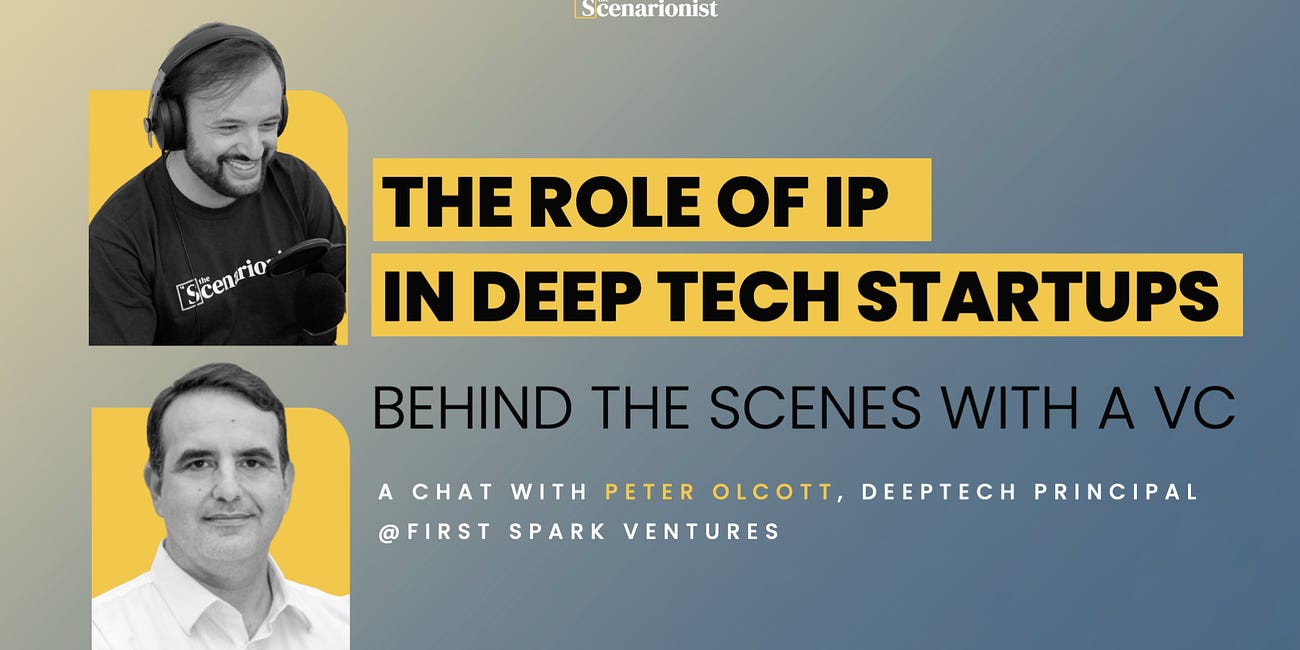Welcome back to Deep Tech Catalyst, the channel by The Scenarionist where science meets venture!
Today, we are thrilled to welcome Sara Holland, IP expert and Partner @ Potter Clarkson.
We're set to explore the intricate world of intellectual property, unraveling the essentials of patents, claims, prior art, and the concept of freedom to operate (FTO)—all crucial elements for anyone venturing into technology innovation.
Let's dive into what a patent really is and why it's so critical for turning technology into a valuable asset for Deep Tech startups.
🎧 Prefer to listen?
Before diving into it, an important disclaimer:
This content is provided solely for educational and informational purposes and should not be interpreted as financial or legal advice. While we strive to clarify the complexities surrounding various agreements and intellectual property, the nuances can be overwhelming. It is essential for entrepreneurs and founders to consult directly with a qualified legal or financial professional to navigate the landscapes effectively.
💡 Key Insights from the Episode
At its core, a patent is a protective measure that grants you as an inventor, exclusive rights to your invention. This could be anything with technical ingenuity—from a breakthrough enzyme to a uniquely engineered cell.
The essence of a patent lies in its ability to safeguard the technical features that set your invention apart. Obtaining a patent means preventing others from making, using, or selling your invention without your permission.
This is pivotal because it secures your intellectual efforts.
In other words, the lack of patent protection can lead to scenarios where your innovation, no matter how groundbreaking, can be replicated and commercialized by others. This not only diminishes the value of your original work but also compromises potential returns on your investment.
By holding a patent, you effectively build a barrier, ensuring that your invention remains uniquely yours to exploit commercially.
Patents from an Investment Perspective
From an investment perspective, patents are invaluable. They provide a layer of security to investors, reassuring them that the technology they invest in is protected against duplication. This assurance is often a prerequisite for venture capital funding or government grants. In essence, a patent amplifies and protect the investability of your technology.
Therefore, having a patent is a significant factor in attracting investment.
It’s important for academics to understanding the commercial impact of a patent: the novelty of your technology is its currency in the marketplace. Publishing your work without securing a patent may render your invention common knowledge, stripping it of its unique commercial potential.
What can be Patented?
Significant distinctions exist regarding what can and cannot be protected across different jurisdictions. Generally, to obtain a patent, the invention must meet specific criteria:
Firstly, it has to be new, meaning it hasn't been disclosed anywhere else in the world in the exact same manner. For example, if someone has previously disclosed an identical invention, whether through oral disclosure, poster presentation, a social media post, or even an obscure document in a language no one reads, it counts as prior art. If your invention is already disclosed in such prior art, it's not considered new.
Moreover, for an invention to be granted a patent, it also needs to be inventive. This means it must not be obvious, considering all the prior art and knowledge in the field. The determination of obviousness is typically judged by a skilled person or someone skilled in the art. This skilled person is not someone who is exceptionally creative but rather follows established protocols and can understand technical papers. They may not make creative leaps on their own. So, what might seem obvious to the inventor, who is deeply immersed in the field, might not be obvious to this skilled person.
Therefore, when considering patent protection, it's crucial to assess whether your invention would be obvious to this skilled person based on existing knowledge. Would it be obvious to someone following protocols and existing knowledge?
🤼 Claims vs Prior Art
Let's differentiate between claims and prior art. “Claims” are the specific parts of a patent application that outline what the inventor seeks to protect. On the other hand, “Prior Art” refers to any information that has been made public before the filing date of the patent application. This includes publications, patents, presentations, or any other publicly available information.
Claims
Claims are the crux of a patent application. These are the parts of the document that define the scope of the invention and are scrutinized for novelty and inventive step by the patent examiner.
Essentially, claims define the scope of protection that the patent provides. When preparing a patent application, it's crucial to draft the claims strategically. It’s common to start with a broad claim—essentially casting the widest net possible to encompass any related inventions.
However, this broad stroke must be refined and sometimes narrowed through the patent prosecution process, as examiners will challenge claims based on prior art, which encompasses all relevant public disclosures.
This is where the role of an attorney becomes crucial.
Attorneys work with inventors to identify the broadest possible concepts and then craft claims around them. These claims are then continuously refined based on feedback from the examiner, often through a series of back-and-forth arguments.
For inventors, providing examples of different scenarios in which the invention could be utilized is invaluable.
Additionally, having data and examples demonstrating the versatility and effectiveness of the invention strengthens the patent application. This broadens the scope of potential claims and increases the chances of obtaining a robust patent.
In summary, while an invention may seem obvious or straightforward to the inventor, it's essential to thoroughly assess its novelty and non-obviousness within the context of existing knowledge in the field. Crafting strategic claims and providing comprehensive examples are key steps in securing a strong patent.
Consulting with an attorney early in the process can greatly aid in navigating the complexities of patent law and maximizing the protection of the invention.
However, before approaching an attorney, it's wise to gather as much data as possible, consider various applications of your invention, and be prepared to broaden your perspective on what constitutes the core innovation. Your attorney will then use this information to draft a patent application that robustly protects your invention, giving you a firmer standing in both protecting and capitalizing on your intellectual property.
Prior Art
For scientists preparing for consultations and patent applications, it's crucial to understand where to look for prior art and how to manage it. Some common sources of prior art include:
Scientific databases: Platforms like PubMed are valuable resources for searching scientific literature related to your invention.
Patent databases: Websites like Google Patents or the European database Espacenet provide access to patent documents worldwide.
Professional networks: Engaging with colleagues, attending conferences, and participating in industry forums can provide insights into existing technologies and developments.
When managing prior art, scientists should be mindful of their own publications. It's important to note that your own prior publications can be used against you in the patent application process. In some jurisdictions like the US, there may be grace periods allowing for a limited time frame after publication to file a patent application, but this varies globally.
🚀 Start Locally and Scale Globally
Regarding strategies for drafting patents that can scale globally, a common approach is to start with a local application, such as a UK application, and then expand internationally using mechanisms like the Patent Cooperation Treaty (PCT).
You might initiate your voyage with a single application, often starting in your home country. This grants you a 'priority date'—think of it as your claim to that moment in time. From there, you have 12 months (the 'priority period') to expand your quest internationally through a PCT application, which doesn't finalize into actual patents but reserves your right to seek them later in specific countries.
This PCT route affords you additional months to survey the commercial landscape, secure funding, and pinpoint the countries where you wish to solidify your patent rights.
🚫 Common Mistakes Scientists Should Avoid
The path to patenting is often fraught with pitfalls, especially for those immersed in the scientific community, where the race to publish can clash with the need to protect innovative ideas.
The most common misstep is not considering intellectual property rights early enough, resulting in premature publication. This act alone can often nullify the novelty of an invention.
Another critical area to consider is ownership. In many countries, including the UK, if you're associated with an institution like a university, it typically retains the rights to intellectual property generated under its roof. This applies whether you're a postdoc, a lecturer, or even a student.
So, if you're envisioning a startup around your research, it's crucial to understand who legally owns the innovation. This is why we see the formation of spin-outs, where the university may file the patent application and then license it to a new company.
On the matter of publishing, once you have a patent application filed, you're free to share your work with the world. It’s about timing—secure your patent application first, then proceed with publications. In cases where you're presenting at conferences before filing, it’s possible to craft your presentation to avoid disclosing the inventive concept. The key is to talk around the innovation without revealing the specifics that make it patentable.
🎯 Freedom to Operate Basics
Lastly, let's touch on freedom to operate (FTO). This concept is distinct from patentability.
Holding a patent does not inherently grant you the freedom to use your invention; it simply gives you the right to prevent others from using it. FTO is about ensuring that in bringing your product to market, you're not infringing on anyone else's patents.
This assessment should be done early on, especially before engaging with investors or entering competitions. It shows a level of due diligence and awareness that can be critical for the future of your venture.
As you consider FTO, it’s wise to investigate the patent landscape. Are there existing patents held by potential competitors that you need to be aware of? Can you design around them, or will you need to consider licensing? Understanding the nuances of FTO can position you more strategically as you progress from concept to commercialization.
Early stage companies may not have exhaustive FTO analyses, but demonstrating awareness and initial steps taken is often a positive sign to investors and industry partners.
This is all for today!
Before you go 👉 Subscribe to make sure you catch all new episodes and our weekly briefing, where we dive into the latest trends and updates shaping the world of Deep Tech!
























